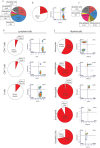Aldh1l1-Cre/ERT2 Drives Flox-Mediated Recombination in Peripheral and CNS Infiltrating Immune Cells in Addition to Astrocytes During CNS Autoimmune Disease
- PMID: 39910805
- PMCID: PMC11799068
- DOI: 10.1002/brb3.70239
Aldh1l1-Cre/ERT2 Drives Flox-Mediated Recombination in Peripheral and CNS Infiltrating Immune Cells in Addition to Astrocytes During CNS Autoimmune Disease
Abstract
Introduction: The transgenic murine Cre/loxP system is deployed to investigate the role of central nervous system (CNS) cell-specific gene alterations in both healthy conditions and models of neurologic disease. The Aldh1l1-Cre/ERT2 line is widely used to target astrocytes with high coverage and specificity within the CNS. Specificity outside the CNS, however, has not been well-characterized, and Aldh1l1-Cre/ERT2-mediated recombination within the spleen has been reported. In many CNS diseases, infiltrating immune cells from the periphery drive or regulate pathogenesis. We tested whether flox-mediated recombination from Aldh1l1-Cre/ERT2 occurs in immune cells in addition to astrocytes and whether these cells traffic from the spleen into the spinal cord during experimental autoimmune encephalomyelitis (EAE), a model of CNS autoimmune disease.
Methods: Two astrocyte-targeted mouse lines were generated with the red fluorescent reporter, tdTomato, by crossing the Cre-recombinase lines, Tg(Aldh1l1-Cre/ERT2)1Khakh and Tg(Gfap-Cre)73.12Mvs, with the reporter line, Gt(ROSA)26Sor. Aldh1l1-Cre/ERT2 was activated with 5 days of intraperitoneal tamoxifen, whereas Gfap-Cre was constitutively active. EAE was induced 2 weeks after tamoxifen, and then spleens and spinal cords were harvested and processed for flow cytometry at various time points after disease onset in EAE versus healthy controls.
Results: In EAE, Aldh1l1-Cre/ERT2, but not Gfap-Cre, induced multiple tdTomato+ immune cell subpopulations in the spleen and spinal cord, including macrophages, monocytes, neutrophils, eosinophils, B cells, CD4+, and CD8+ T cells.
Conclusion: Use of Aldh1l1-Cre/ERT2 should therefore account for recombination in both astrocytes and immune cells in disease models involving peripheral immune cell infiltration into the CNS.
Keywords: Aldh1l1‐Cre; CNS infiltrating immune cell; Gfap‐Cre; astrocyte‐specific promoter; central nervous system (CNS) autoimmune disease; experimental autoimmune encephalomyelitis (EAE); flow cytometry.
© 2025 The Author(s). Brain and Behavior published by Wiley Periodicals LLC.
Conflict of interest statement
The authors declare no conflicts of interest. Dr. Mario Amatruda was previously employed as a senior scientist at Biogen in 2023.
Figures





References
-
- Beyer, F. , Ludje W., Karpf J., Saher G., and Beckervordersandforth R.. 2021. “Distribution of Aldh1L1‐CreER(T2) Recombination in Astrocytes Versus Neural Stem Cells in the Neurogenic Niches of the Adult Mouse Brain.” Frontiers in Neuroscience 15: 713077. 10.3389/fnins.2021.713077. - DOI - PMC - PubMed
MeSH terms
Substances
Grants and funding
LinkOut - more resources
Full Text Sources
Molecular Biology Databases
Research Materials
Miscellaneous

